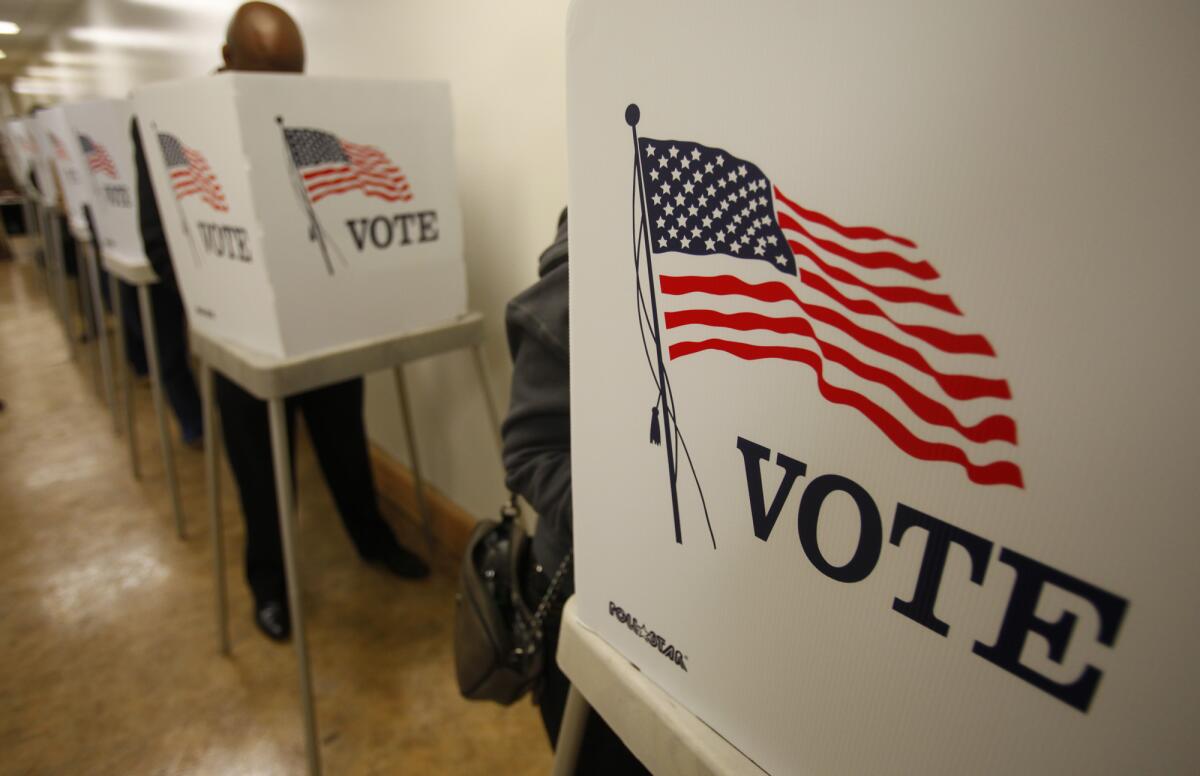California’s ballot could be a blockbuster next November

Early voters line-up before dawn at the Los Angeles County Registrar-Recorder’s office in Norwalk on Nov. 5, 2012.
Reporting From Sacramento — Call it a dream for California political consultants, a nightmare for voters or an electoral extravaganza: The November 2016 ballot could feature a bigger crop of statewide propositions than at any time in the past decade.
“The voters pamphlet is going to look like the Encyclopaedia Brittanica,” said Steve Maviglio, a Democratic campaign strategist.
The list of measures is very much a work in progress. Most campaigns are still gathering voter signatures or waiting for their proposals to be vetted by state officials.
But political strategists have identified at least 15 -- perhaps as many as 19 --measures that all have a shot at going before voters next fall.
The last time California’s ballot was that long was in November 2004, when there were 16 propositions. The March 2000 ballot had 20.
A number of political forces help explain why so many are lined up now. For starters, there’s the 2011 law that moved everything but measures written by the Legislature to the general election ballot. As a result, June primary ballots are now almost barren of contentious campaigns.
There is also a lingering hangover from the state’s record-low voter turnout in 2014: a new and extremely low number of voter signatures needed to qualify an initiative for the ballot.
“There’s no real obstacle this time,” said Beth Miller, a Republican campaign consultant.
State law sets the signature threshold at a percentage of votes cast in the most recent gubernatorial election. That has lowered the bar to a level not seen since 1975, opening the door of direct democracy more widely for activists with smaller wallets.
“It’s made it cheaper to qualify an initiative,” said Gale Kaufman, a longtime Democratic campaign consultant who is leading the charge on initiatives to legalize marijuana and prolong a temporary tax increase approved by voters in 2012.
Which of the likely propositions might become a centerpiece campaign next year remains unclear; only five have qualified for the ballot. But perhaps a dozen more are close to securing a spot or have substantial funding behind their signature-gathering efforts.
The effort to legalize recreational use of marijuana, boosted recently by former Facebook and Napster executive Sean Parker, will undoubtedly make national headlines. So, too, might the effort spearheaded by Lt. Gov. Gavin Newsom to ban the possession and sale of large ammunition clips for guns and require background checks on those who buy ammunition.
Tax measures also typically have high profiles. Last week, an alliance of teachers, state and local employees, hospitals and doctors announced a new push to extend the 2012 tax hike. Healthcare groups are backing a proposal to raise California’s cigarette tax by $2 a pack.
Other proposals form a political potpourri of ideas and issues. School groups have qualified a $9-billion school construction and renovation bond measure; organized labor and several Democratic officeholders are backing a proposed increase in the state minimum wage; and two efforts would impose new rules of public disclosure on the legislative process and campaign contributions.
There is a also a closely watched effort to lower the cost of taxpayer-subsidized prescription drugs, with the pharmaceutical industry promising a well-funded campaign to defeat it.
Wild cards that could dramatically affect the state’s electoral landscape include a much-discussed move to substantially shrink the pensions of public employees.
All of this may be the equivalent of a full employment act for political professionals, but a lengthy and dense ballot can turn off voters.
“What ends up happening is voter fatigue,” Kaufman said.
Political scientists say voters simply give up on trying to follow so many disparate propositions and skip many of them -- or simply vote no.
A plethora of ballot measures also could raise the costs of television and online advertising to record levels, leaving initiative backers scrambling to raise cash.
“There’s only so many places you can tap the well,” said Fiona Hutton, a public affairs strategist in Los Angeles. “And if there are multiple measures, how far does that donor base get stretched?”
And more campaigns will be competing for a limited amount of television and radio ad time.
“Some campaigns are never going to get enough oxygen to be able to inform voters,” said Rob Stutzman, a GOP consultant working on the school bond effort.
Perhaps the biggest unknown is whether a 2014 law designed to offer a release valve for the pressure of initiative campaigns will have any effect. It allows backers of an initiative to withdraw their measure if they strike a deal on similar legislation at the state Capitol.
“Are there things that there’s an appetite for the Legislature to deal with?” said strategist Miller. “It’s a new wrinkle, and it’s not one that anyone’s ever dealt with before.”
Follow @johnmyers on Twitter and sign up for our daily Essential Politics newsletter
Hoy: Léa esta historia en español
ALSO
Light from Navy test fire courses across the Southern California and Arizona sky
Why some LAUSD teachers are balking at a new approach to discipline problems
Billionaire investor Ron Burkle says bankrupt Fresh & Easy ‘was in a free fall’
More to Read
Get the L.A. Times Politics newsletter
Deeply reported insights into legislation, politics and policy from Sacramento, Washington and beyond. In your inbox three times per week.
You may occasionally receive promotional content from the Los Angeles Times.








